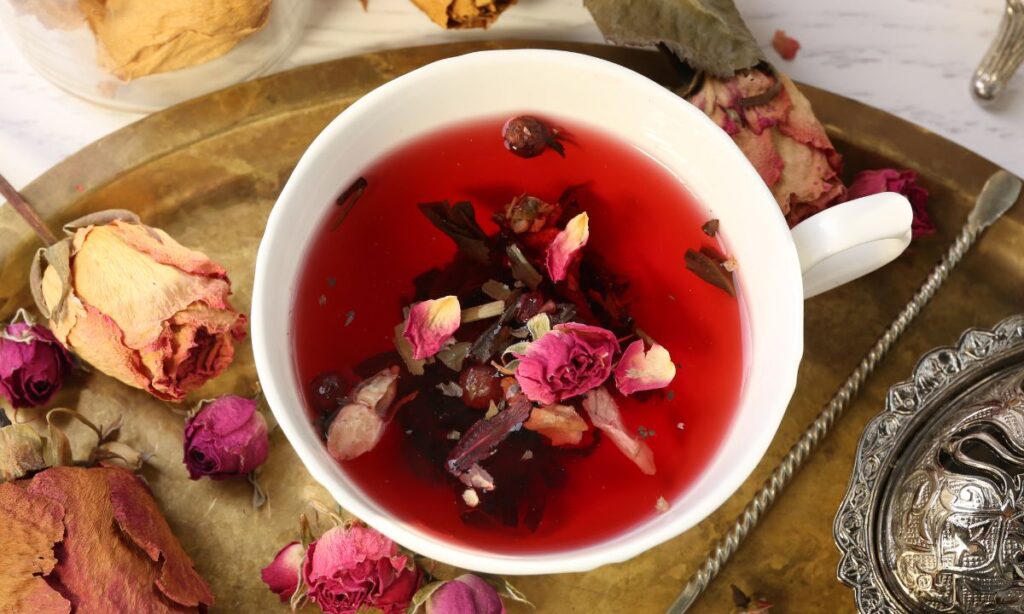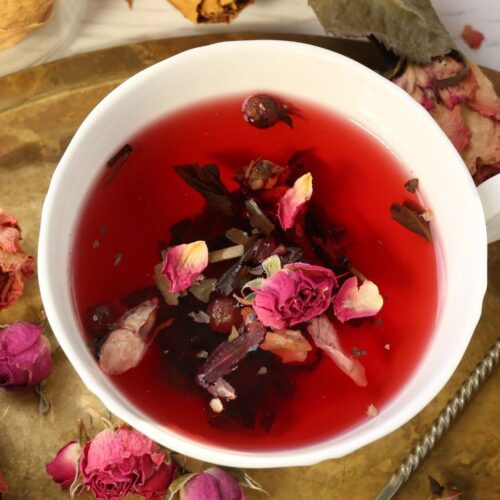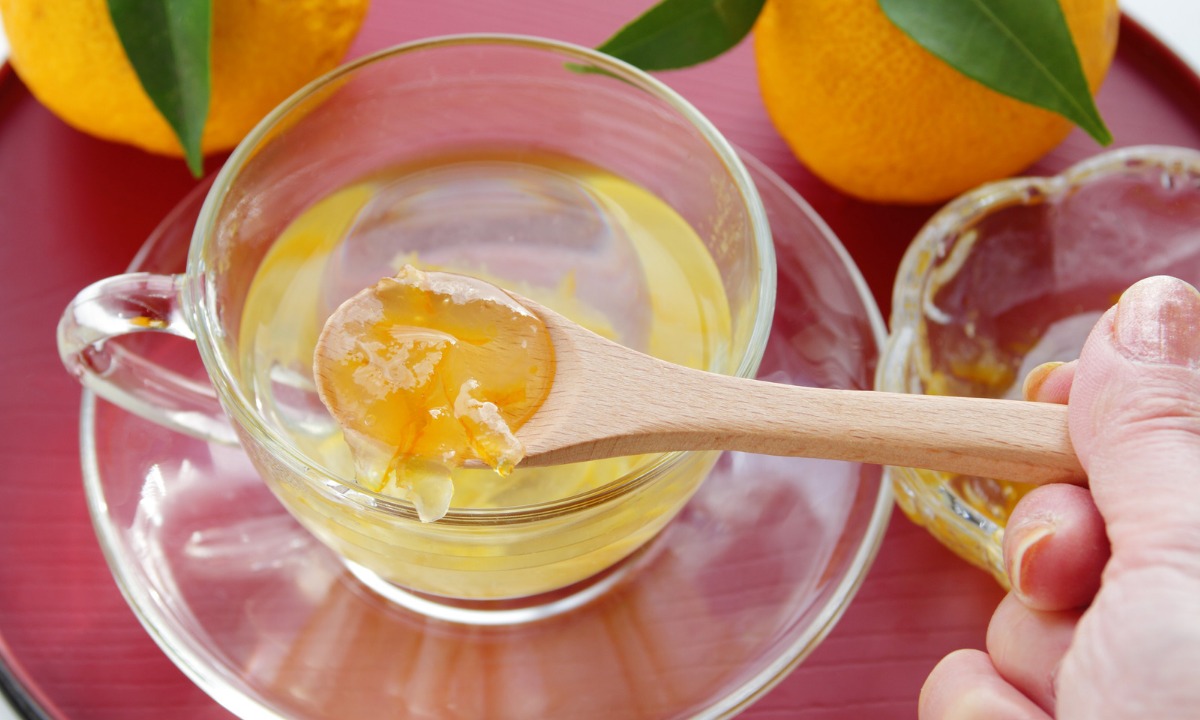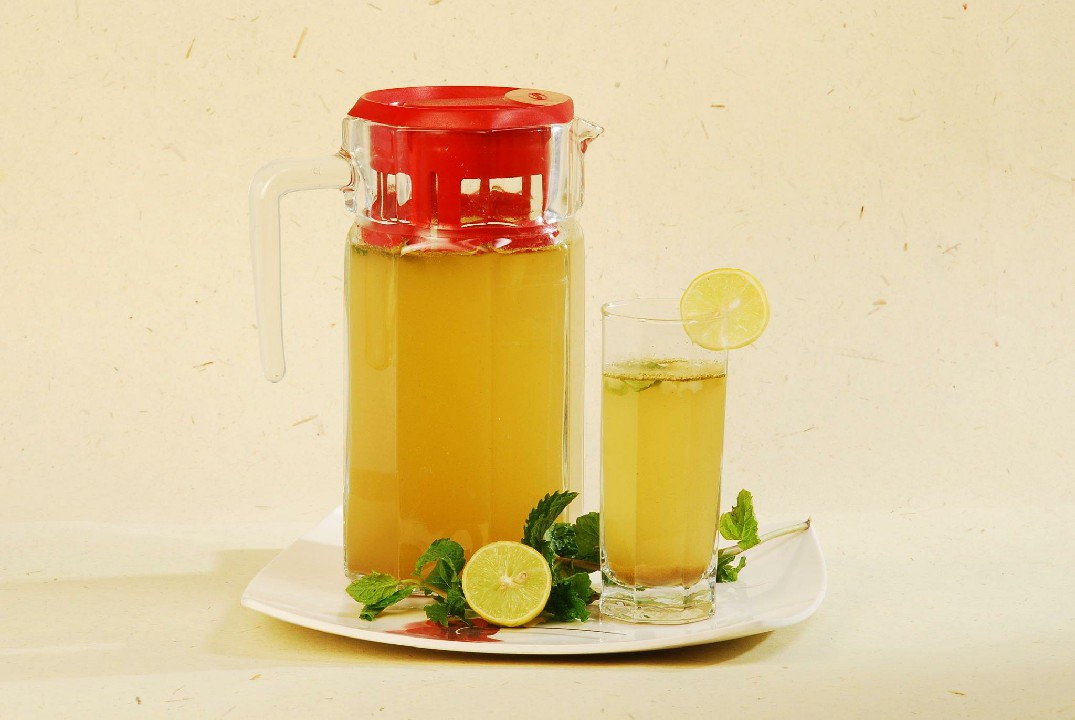
Table of Contents
The rose tea, whose claimed roots are in China, balances its beauty with an abundance of fragrance and a depth of real benefits that were brought with the flower as it started to be traded along the Silk Road, from China to the middle east, northern Africa, and Europe.
Similar to Kashmiri Pink Tea & Dragon fruit tea this delightful and aromatic Rose Tea Recipe is a must-try.
A herbal beverage called a rose tea recipe is created by soaking dried rose petals or buds in water. A herbal tea infusion or tisane is another name for it.
Rose tea can be brewed to make hot or iced tea and is naturally caffeine-free.
Rose tea recipe and rosehip tea are two distinct kinds of tea with various health benefits.
The rose plant’s fruit, located below the petals, is used to make rosehip tea. To learn how to prepare the ideal cup of rose tea, read out my detailed guidelines.
How to Make Rose Tea?

Rose Tea Recipe
Equipment
- Kettle
- Mortar and pestle
- Serving Cups
Ingredients
- 1-2 cups Rose petals fresh or dried petals
- 2-3 cups Water
- 1-2 tsp Green tea or Black tea is optional
- ½ -1 tbsp Honey or Sugar
- ½ -1 cup Milk
- ½ inch Cinnamon stick
- 1 tsp Cardamom powder
- 1 tsp Ginger paste
- 3-4 Cloves
- ½ tbsp Fennel Seeds
- 1 tbsp Rose syrup
- A generous pinch of Chai masala
Instructions
- In a mortar and pestle, crush the ginger, fennel seeds, cinnamon stick, cloves, and cardamom powder.
- Place a kettle full of water on the burner.
- Add the ginger, fennel seeds, crushed cinnamon, and cloves after that.
- Add sugar or honey, green tea leaves, and rose petals to the kettle.
- Boil for 3-4 minutes after constantly swirling.
- Cardamom powder should be added and thoroughly mixed in.
- After adding the milk, bring it to a boil.
- Boil for 6-7 minutes on low heat.
- Boil for 2 more minutes after adding the rose syrup.
- Tea should be strained into cups.
- Rose Tea should be served right away with butter cookies or jeera biscuits.
Notes
- Great options for refined sugar are brown sugar, coconut sugar, and palm sugar.
- You can substitute organic edible rose petals (from fresh roses), rose buds, or rose powder for dried rose petals.
- You can drink rose tea hot or cold, with or without milk or sugar. You are entirely in charge.
- Rose tea can be made and kept in the refrigerator for up to 4 days. Please keep it in a covered, airtight glass container.
Health benefits of Rose Tea
It is believed that adding rose tea to your health regimen can aid with several illnesses, from menstruation cramps to arthritis. Some people think that this tea can help with digestion problems and insomnia.
The vitamin C in one teaspoon of rose hips is the same as in six oranges! Rose bud tea, however, is safe to drink in moderation.
1. May Enhance Menstrual Health
One of the most effective natural remedies for painful or long periods is probably rose tea, which may help balance hormones and relieve uterine congestion and get rid of cramps and mood swings that are often connected to menstruation. Although more study is required, preliminary results are positive.
2. May Boost the Immune System
Like many other herbs made from other plants and flowers, Rose tea may be rich in vitamin C, one of the essential vitamins for human health. Because it can promote the generation of white blood cells and serves as an antioxidant, vitamin C is known to be a core part of our immune system and may reduce oxidative stress.
3. Might Help to Reduce Respiratory Problems
Rose tea is usually prescribed or advised for calming the respiratory system, lungs, and throat, so drinking it while you have the flu or a cold can be a great option. Eliminating mucus and phlegm, which can contain germs and other pathogens and support their growth, may also be helpful.
4. Potentially Good for Mood
Tea may have a naturally uplifting quality that makes it a fantastic choice for people who may feel sad, depressed, or stressed. Persons who favour alternative medicine may claim that rose tea may be helpful for those who are depressed, even if there is no medical evidence to back up the claim.
5. Promising Digestion Aid
This tea’s antibacterial effects work fast to treat various infections, including those that may affect the digestive system or gut. Rebalancing the microflora in the intestines might help ease digestive problems such as diarrhea, constipation, cramping, and bloating.
Side effects
Though the nutrient value of rose tea may have possible health benefits, you should speak with your doctor before incorporating it into your diet. For those with specific medical conditions, it could be harmful. An allergic reaction is a side effect that is most commonly mentioned.
1. Asthma and allergies
Some people should avoid drinks like rose tea because they are allergic to the rose plant. Based on one study, allergies to rose hips can cause asthma to develop.
2. Medicinal Effects
Certain medicines, such as blood thinners or antidepressants, may interact with rose tea.
3. Labour and delivery Considerations
The safety of rose tea for pregnant mothers has not been researched.
4. High levels of vitamin C
Excessing too much vitamin C in your diet might make you feel nauseous and dizzy, have migraines, and have heartburn. People who consume a lot of vitamin C may develop kidney stones. As a result, those who suffer from illnesses linked to iron may experience increased symptoms. It can also improve iron absorption.
Conclusion
Dried rose buds can be used to make a soothing herbal tea in either hot or cold water. Rose petals and a considerable number of spices are added to the tea to enrich it. If you enjoy tea, you will enjoy drinking this one in the morning. These delicate flowers provide a flavorful beverage that is low in calories, light in taste, and pleasant. Due to its high levels of polyphenols, vitamin A, vitamin C, and various other antioxidants, rose tea has many health benefits.
FAQs
What is added to Rose tea?
Rose-hips, rose petals, and rosebuds are among the components used to make rose tea, a herbal refreshment. To brew teas with floral flavors, the tea is typically combined with tea leaves, like black tea or green tea. Also, you can mix the drink with other herbal teas, including rooibos, chamomile, and hibiscus.
Can I have rose tea regularly?
There is some caffeine in common daily beverages like tea and coffee. The caffeine-free and blend-free infusion of rose petals contains no tea. Thus, rose tea might be a perfect substitute for your everyday coffee. Rose tea might help in the body’s detoxification process.
What bad effects does rose tea possess?
Rose tea may react with some medications, such as blood thinners or antidepressants. The safety of rose tea for pregnant mothers has not been tested. Too much vitamin C in your diet might make you feel nauseous and dizzy, have migraines and have heartburn.
What results from frequent rose tea consumption?
It has been proven that consuming rose water has beneficial impacts on the digestive system. By boosting bile flow relieves common diseases, including bloating and upset stomach, by reducing their symptoms. The use of rose water as a laxative is another benefit.



